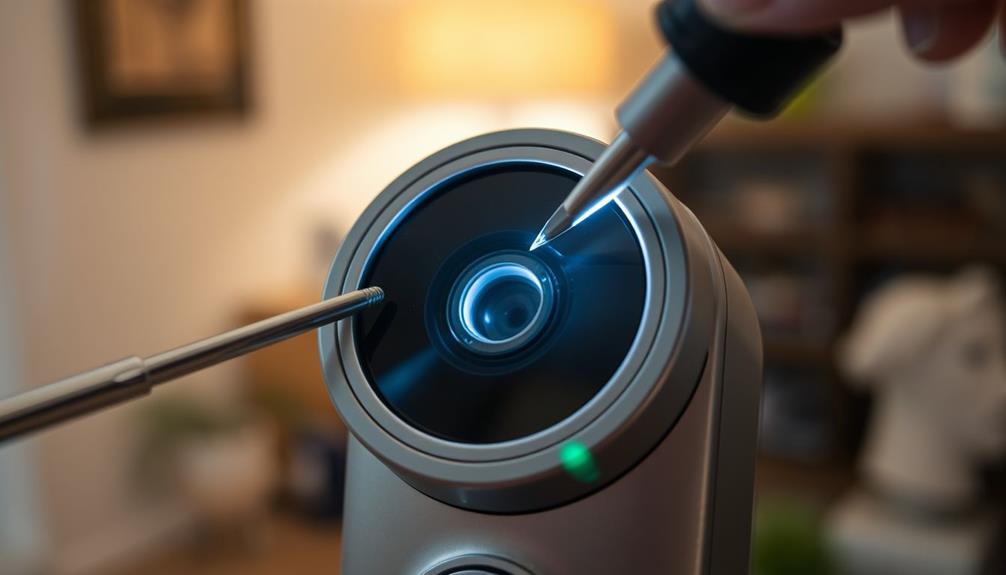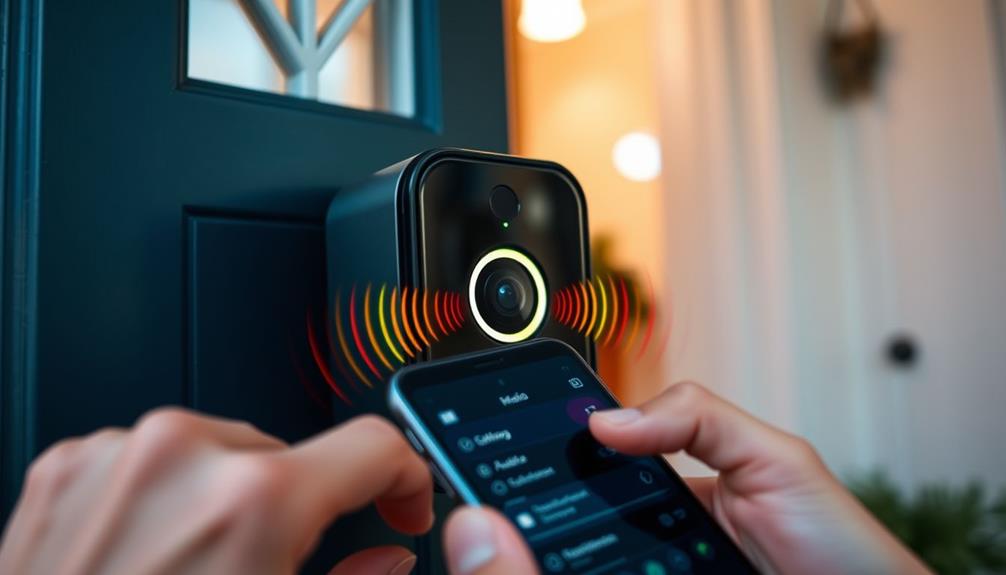To get screws out of your Ring Doorbell, start by powering it off and gathering a T6 or T15 Torx screwdriver, depending on your model. If screws are stripped, try using a rubber band for grip. Placing the band over the screw head and using the screwdriver can help. For stubborn screws, apply a penetrating oil, like WD-40, and let it seep in. If that fails, consider using pliers for better leverage or even a drill with an extractor bit. There are more tips and methods to guarantee you tackle those screws effectively ahead.
Key Takeaways
- Ensure the power is off before attempting to remove screws for safety.
- Use the correct T6 or T15 Torx screwdriver to avoid stripping screws.
- Apply penetrating oil to stubborn screws and allow it to seep before removal.
- Employ pliers or a rubber band for better grip on stripped screw heads.
Causes of Stripped Screws
Stripped screws often happen when you over-tighten them, wearing down the threads and making removal a real hassle. When you apply too much torque, the screw head can lose its grip, leading to a stripped screw that's challenging to deal with later.
Additionally, if you frequently remove screws, the repetitive motion can gradually damage the screw head, increasing the likelihood of stripping over time. Using the wrong screwdriver size is another common cause. A mismatched tool can slip and cause the edges of the screw head to round off, preventing effective engagement.
Misalignment during installation can also contribute to stripping; if you don't apply sufficient pressure or aren't lined up properly, the risk of damaging the screw increases.
Regular maintenance can help mitigate these issues, similar to how proper HVAC maintenance guarantees the longevity of your systems. By checking your screws periodically, you can catch signs of wear before they become stripped.
Making sure you use the correct tools and techniques is essential in preventing stripped screws, allowing you to easily remove them when necessary. Understanding these causes will help you take better care of your screws and avoid the frustration of dealing with stripped heads in the future.
Tools Required for Removal

To effectively remove screws from your Ring doorbell, you'll need specific tools tailored to the model you're working with. For standard models, grab a T6 Torx screwdriver, while the Ring Doorbell Pro requires a T15 Torx screwdriver. Having the right screwdriver is essential for a smooth removal process.
Additionally, keeping your air quality in check can help maintain a comfortable working environment while you tackle this task, especially if you use an air purifier to reduce dust and allergens.
If you encounter stubborn screws with stripped heads, a pair of needle-nose pliers can help you grip and turn them. Sometimes, using a rubber band can also improve your grip; just place it between the screwdriver and the stripped screw for added friction.
In more challenging cases, a drill equipped with a screw extractor bit might be necessary to extract particularly stuck screws. Additionally, keep some penetrating oil nearby. Spraying it on stuck screws can help loosen them before you attempt removal.
Techniques for Unscrewing

When it comes to unscrewing the screws on your Ring doorbell, having the right techniques can make all the difference.
You can use methods like the rubber band technique for better grip or needle-nose pliers for those stubborn screws that just won't budge.
Let's explore these strategies to help you successfully remove those screws.
Recommended Tools and Techniques
Using a T6 Torx screwdriver is essential for effectively removing screws from your Ring doorbell. Make certain you apply firm pressure while turning counterclockwise to avoid stripping the screws.
If you're looking for tools that enhance your home security, check out top garage door openers for added convenience.
If you encounter a stripped screw, a rubber band can enhance grip, but for more stubborn screws, consider using penetrating oil. Apply it to the screw and let it sit for a few minutes to loosen it.
If the screw still won't budge, needle-nose pliers can come in handy. Grip the raised head of the screw with the pliers to gain extra leverage and twist counterclockwise. This method often provides the necessary torque to break free a stubborn screw.
In extreme cases where all else fails, you might need to drill a small hole in the screw head. After creating the hole, use a screw extractor bit to safely remove the screw without damaging your doorbell. This technique is effective when dealing with screws that are too damaged or corroded to remove with standard methods.
Rubber Band Method
The rubber band method offers a simple yet effective way to grip and unscrew stripped screws from your Ring doorbell. To start, place a thick rubber band over the stripped screw head. This increases friction and improves your screwdriver's grip. Verify you use the correct size screwdriver, like a T6 or T15 Torx, to fit snugly against both the rubber band and the screw. With the rubber band in place, apply steady pressure while turning the screwdriver to avoid further damaging the screw head. This technique can save significant time and effort compared to more invasive methods. Once you have successfully removed the stripped screw, you can refer to tutorials on **how to install a Ring doorbell** to ensure proper setup and avoid common pitfalls during installation.
Here's a quick guide to help you effectively use this method:
| Step | Action | Notes |
|---|---|---|
| 1 | Place the rubber band over the screw head | Increases friction |
| 2 | Insert the screwdriver into the rubber band | Verify a snug fit |
| 3 | Apply gentle pressure and turn the screw | Turn counterclockwise |
As you turn the screw, apply gentle but firm pressure. This helps the rubber band grip the screw, making removal easier. If you find it's not working, try a thicker rubber band or layer multiple bands for extra grip. This technique is especially useful for screws that are rounded or worn down, as the rubber band fills in the gaps and provides traction.
Pliers for Extra Grip
If the rubber band method doesn't give you the results you need, pliers can offer a reliable alternative for gripping and unscrewing stripped screws on your Ring doorbell.
To maximize your chances of success, use needle-nose pliers to grip the raised edges of the screw head. Applying firm pressure while turning counterclockwise can enhance leverage for removal, much like the techniques used in optimal use and cleanup of an airless paint sprayer.
Ensure the pliers are positioned securely on the screw head to prevent slipping, which could lead to further stripping or damage.
If the screw is particularly stubborn, consider using locking pliers for a stronger grip that helps turn the screw without excessive force.
Be cautious when using pliers on stripped screws, as too much pressure can cause more damage. Gentle and steady pressure is advisable.
For screws that spin in place without loosening, try pulling upwards with the pliers while simultaneously turning counterclockwise. This technique can help break any stuck connections, making it easier to remove those Security Screws from your Ring doorbell.
With the right approach, pliers for extra grip can be your best friend in this DIY endeavor.
Using Penetrating Oil

Applying penetrating oil like WD-40 can effectively loosen stuck screws on your Ring doorbell. When you encounter screws that won't budge, this method is often a game-changer. Not only does it help with stubborn screws, but it also reflects the significance of patience and perseverance in tackling challenges, much like the heartfelt verses to bless loved ones on special occasions.
Start by spraying the penetrating oil directly onto the stuck screws, allowing it to seep into the threads. This oil helps break down rust and debris, making it easier to remove screws.
After applying the oil, give it several minutes to penetrate. This waiting period is essential, as it allows the oil to work into the threads.
Once enough time has passed, grab your T6 or T15 Torx screwdriver, depending on your Ring doorbell model. Turn the screw counterclockwise to attempt removal. Be sure to apply steady pressure to avoid stripping the screw. If the screw feels stuck, consider applying a small amount of lubricant, but be cautious not to damage any electrical components. If you’re still having trouble, it might be helpful to consult a detailed guide on how to resolve Ring doorbell issues, which can provide step-by-step solutions for various installation or removal problems.
If the screws still resist, don't hesitate to reapply the penetrating oil and allow additional time for it to take effect. For better leverage, you can use pliers to gently twist the screw head, but be careful not to strip the screw.
Rubber Band Method

Using a rubber band can give you the extra grip needed to remove stubborn screws from your Ring doorbell. This method is particularly effective for screws that have lost their threading and are tough to extract. Here's how to do it:
- Choose a thick rubber band that's wide enough to cover the entire screw head.
- Place the rubber band over the stripped screw.
- Use a screwdriver that fits your screw size (usually T6 or T15).
- Apply firm, steady pressure while turning the screwdriver counterclockwise.
If the screw still won't budge, try using a thicker rubber band or layering multiple bands for improved grip.
Here's a quick reference table to help you:
| Step | Action |
|---|---|
| 1. Select Rubber Band | Choose a thick, wide rubber band |
| 2. Position | Place it over the stripped screw head |
| 3. Choose Screwdriver | Use the correct size (T6 or T15) |
| 4. Twist | Turn counterclockwise with steady pressure |
Using the rubber band method can increase your chances of successfully removing that stubborn screw without damaging your Ring doorbell.
Employing Pliers Effectively

When you're trying to remove stubborn screws from your Ring doorbell, using the right type of pliers can make all the difference.
Needle-nose pliers are often your best bet for getting a firm grip on the screw head.
Additionally, understanding the tools needed for home maintenance, such as pliers, is essential for effective problem-solving in DIY projects essential items for a home cleaning kit.
Types of Pliers Used
Needle-nose pliers are perfect for gripping small, stripped screw heads, making them essential for tackling tricky screws on your Ring doorbell. Their elongated design allows you to access tight spaces with ease, which is vital during this process.
Here are some other types of pliers you might consider using:
- Locking pliers: These provide a strong grip on stubborn screws, preventing slippage while you turn them counterclockwise.
- Flat-jaw pliers: Ideal for screws with a slightly raised head, these pliers help apply even pressure while turning.
- Adjustable pliers: Great for varying screw sizes, they can adapt to fit different heads securely.
When using pliers, make certain to apply consistent pressure and turn slowly to avoid damaging the screw head or the surrounding components.
Always verify your pliers are well-maintained and free of rust or debris to maximize grip and efficiency during the removal process.
Techniques for Better Grip
A firm grip on the screw head is essential for effective removal, so position your pliers carefully to maximize leverage. Start by using needle-nose pliers to grip the raised edges of the screw head. Apply steady pressure while turning counterclockwise; this enhances your leverage and makes it easier to loosen the screw.
If you encounter a stripped screw, maintain a firm grip with the pliers and rotate it gently, avoiding excessive force that might cause further damage.
For particularly stubborn screws, pliers with rubber grips can provide extra friction, preventing slippage while you work. Confirm your pliers are positioned at a right angle to the screw for ideal torque application. This small adjustment can greatly improve your chances of loosening the screw effectively.
If the screw head is flush with the surface, use the pliers to gently pry the edge while turning. This can create a better grip and make removal much easier.
Alternative Screwdrivers to Try

If you're struggling to remove the screws from your Ring Doorbell, experimenting with alternative screwdrivers can make a significant difference. Sometimes, the right tool is all you need to get the job done without hassle.
Here are a few options to evaluate:
- T15 Torx Screwdriver: If the T6 isn't gripping well, a T15 might fit better in slightly stripped heads.
- Larger Flathead Screwdriver: Use this to create leverage by pressing down firmly into the screw head while turning counterclockwise.
- Precision Screwdriver Set: This offers various sizes and types, helping you find the perfect fit for your specific screw shape.
Each of these options can help you gain better control when trying to remove those stubborn screws.
Remember, ensuring a good fit is key to preventing further stripping and damage, so don't hesitate to try different screwdrivers until you find the one that works best for you.
Happy unscrewing!
When to Use a Drill

Using a drill becomes essential when traditional methods, like screwdrivers or pliers, struggle to remove stubborn or stripped screws on your Ring Doorbell. If you've tried other tools without success, it's time to grab that drill and an extractor bit.
Before you start, make certain you have the right screw extractor bit—most Ring doorbells require a T6 or T15 bit. Here are some key steps to take into account:
| Step | Action | Tip |
|---|---|---|
| 1. Assess the Screw | Check for stripping or corrosion | Look for signs of rust or debris |
| 2. Prepare the Drill | Select the appropriate extractor bit | Verify it fits the stripped screw size |
| 3. Create a Guide Hole | Drill a small hole in the screw head | This helps the extractor grip better |
| 4. Apply Pressure | Set the drill to reverse mode | Use steady pressure to avoid damage |
If the screw remains stuck, applying penetrating oil beforehand can make a significant difference. This method not only saves time but also helps you avoid damage to your doorbell.
Contacting Ring Support

When you encounter issues with stuck or stripped screws on your Ring Doorbell, reaching out to Ring Support can provide the guidance you need. Their support team is ready to assist you, whether through live chat, email, or a phone call.
Here's how you can make the most of contacting Ring Support:
- Visit the official Ring website for quick access to various support options.
- Prepare a detailed description of your problem to help the support team understand your issue better.
- If you prefer to speak directly, give their dedicated phone support line a call—just be aware that wait times can be longer during peak hours.
Utilizing Ring Support is a great way to resolve issues effectively. The community forums are also helpful if you want to see if others have faced similar problems.
Don't hesitate to reach out, as the right guidance can make a significant difference in getting your doorbell back up and running smoothly.
Preventing Future Stripping

To keep your Ring Doorbell screws in good condition and prevent future stripping, always use the correct size T6 or T15 Torx screwdriver for installation and removal. Using the right tool guarantees a snug fit, reducing the risk of stripping the screw head.
When tightening screws, apply gentle, steady pressure. Over-tightening can wear on the screw and threads, making them more susceptible to damage.
Limit how often you remove screws. Frequent removals can wear down the threads over time, compromising the screw's integrity. Regularly inspect your screws for signs of loosening or damage. Catching issues early allows you to maintain the screws and prevent future stripping.
Additionally, invest in high-quality tools that are well-maintained. Poor-quality or worn tools can damage screw heads, making it harder to tighten or loosen screws effectively.
Frequently Asked Questions
How to Remove Ring Doorbell Without Special Screwdriver?
If you need to remove something without a special screwdriver, start by using a flat-head screwdriver to gently pry and turn the screw.
You can also place a rubber band between the screwdriver and screw head for better grip.
If there's enough exposure, try using needle-nose pliers to grip and turn.
For stubborn screws, applying penetrating oil can help loosen them before you attempt removal, making the process easier for you.
How to Unscrew an Old Ring Doorbell?
Imagine trying to open a stubborn jar of pickles; sometimes, a little finesse is all it takes.
When you're unscrewing an old doorbell, grab a T6 or T15 Torx screwdriver and apply penetrating oil to the screws.
Let it sit, then turn counterclockwise with steady pressure.
If they're stripped, try a rubber band for grip or needle-nose pliers.
For the really stubborn ones, a screw extractor bit might just save the day!
How to Remove Security Screws?
To remove security screws, you'll need the right tools.
Grab a T6 Torx screwdriver, as it's designed for these screws.
If they're stuck, try applying some penetrating oil and wait a few minutes.
For stripped screws, place a rubber band over the head for better grip.
If they still won't budge, use pliers for extra leverage.
In extreme cases, a screw extraction tool or drilling might be necessary to get them out.
How Do I Get the Mounting Plate off of My Ring Doorbell?
You know that feeling when something's just out of reach?
To get the mounting plate off your Ring Doorbell, start by locating the security screws at the bottom.
Grab a T6 Torx screwdriver and turn those screws counterclockwise.
If they're stuck, a little penetrating oil can help.
And if you've stripped any screws, a rubber band can boost your grip.
If all else fails, pliers or a screw extractor might be your best bet!
Conclusion
To summarize, tackling stripped screws on your Ring doorbell can be frustrating, but with the right techniques and tools, you can easily resolve the issue.
For instance, a homeowner named Sarah successfully removed stubborn screws using the rubber band method after trying multiple screwdrivers without luck.
By being proactive and employing these strategies, you'll not only fix the problem but also prevent future stripping, ensuring your doorbell remains securely mounted for years to come.









